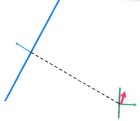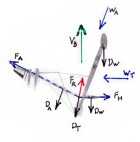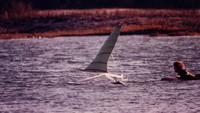High-Speed Sailing
| Vessel Name: | Sailien |
| Vessel Make/Model: | Experimental/custom |
28 September 2013
The America’s Cup
I watched, with interest, the videos of the 34th America’s Cup. At last we have fast sailboats engaged in a competition that is fun to watch. The virtual images (such as course boundaries, distance grid lines, separation between boats, etc.) overlaid on the real images really helps to keep the race [...]
31 August 2013
100 Knots for Hydroptere?
The latest news from Hydroptere is that they have plans for a 100 knot sailboat. This was posted on 26 Aug 2013, so look for that date at this address. http://hydroptere.com/en/the-news/last-news/
17 November 2012
Aptly named Sailrocket, blasts off!
While yet to be ratified, Sailrocket posted an average speed over 500 meters of 59 knots. I will not be surprised if they increase their record into the 60 knot range during this record attempt.
02 January 2012
More drag for VSR2?
I want to start by pointing out that the whole VSR2 team has done a stellar job and has demonstrated conclusively that the forces that drive a sailboat can be aligned for roll stability without using ballast and without using any down-force. (Trifoiler achieved roll stability by using down-force, but [...]
18 December 2011
My analysis of Sailrocket
I copied a diagram of VSR2 (wing doesn’t show well) and added in the major force arrows that apply. Be aware that these arrows are not correct in terms of scale (length) and some of their locations are guesses, however I believe I’m correct enough for us to learn something about what VSR2 has been [...]
23 October 2011
60 is within reach, what’s next?
I have been watching Sailrocket’s progress with great interest and there’s no question they have a winner. I fully expect to see them reach 60kt in the near future. Sailrocket has now demonstrated what I first learned with my models and again with my full-sized prototypes, that if you get the forces [...]
Beyond 50
The last barrier to high-speed sailing is fluid dynamics. Many seem to think that it's the first barrier, but it's the last. The best recent example we have of this is Wotrocket. They crashed because they couldn't control the craft (stability) doesn't matter how good their fluid dynamics are. Interestingly enough we have two other types of craft proving to us that fluid dynamics is the least important factor (so far) in high-speed sailing. A few of you might be surprised at this but the windsurfers and kiteboarders are the least efficient sail craft in the high-speed arena and yet they are currently the fastest! We can easily see this by comparing the true wind speed (45 knots) with the record speed (50 knots). If we look at Yellow Pages 46 knot record in about 19 knots of wind we can see a huge difference in efficiency. The kiteboarders are going about 1.1 X the true wind speed and Yellow Pages about 2.4 X the true wind speed. Now the efficiency drops off as the speed increases but a craft as efficient as Yellow Pages could break 50 knots in 25 knots of wind.
Those of you, who have read Bernard Smith's book "The 40 Knot Sailboat", will know that Yellow Pages proved Smith was right in his calculations that we should be able to go 2.4 times the wind speed. But we can do even better than 2.4 times the wind speed by improving our fluid dynamics. There's a lot more speed ahead.
Bob
About & Links
- Bob's Surfing Blog
- Bob's Website
- Greenbird (Windjet)
- l'Hydroptere
- Le Projet Dared
- Macquarie Speed Sailing Team
- Monofoil Sailing
- Mountain Goat STOL
- Mr Smith's Amazing Sailboats
- Patent Office (Search)
- Radboat
- Sailien Prototypes (early), Delta, etc.
- Sailien Video
- Sailien Website
- The Basics of Surfboard Design
- The Basics of Surfboard Design en Espanol
- The Swedish Speed-Sailing Challenge
- Trifoiler
- Vestas Sailrocket
- Windjet Project
- WSSRC


